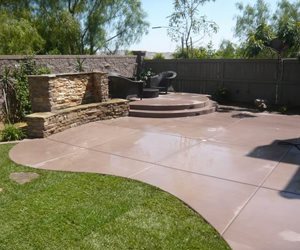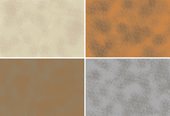How To Add Color To Concrete Mix

This patio was colored with integral pigments.

Concrete Colour Nautical chart
Use this chart to compare the five most pop color choices for outdoor decorative physical. Acquire the pros and cons of each color and what style of home they pair well with.
Concrete can be colored in iv unlike means: stains, integral pigments, color hardeners and dyes. Each of these coloring methods produces different looks and comes with their own set of advantages and disadvantages. Bank check out the information beneath to observe out which coloring methods suits your needs.
Staining Physical
Stains are popular because they can be used on both new and existing concrete. They produce subtle, globe-toned colors that appeal to many homeowners and blend well with natural surroundings. Typical stained physical colors include tans, browns and terra cottas.
Considering they penetrate the surface of the concrete, stains produce permanent color that is UV stable. This ways that most stains can exist used outdoors without fading. Stains are limited in that they are semi-transparent, significant they won't hide existing blemishes or patchwork.
Cost: $five-10 per square human foot
Coloring Concrete Integrally
Integrally colored concrete is but an option for new pours. Pigments are added to the concrete mix prior to placement then that the colour goes all the style through. This is an reward because the color cannot exist worn or chipped abroad, additionally it will not fade.
For integrally colored concrete, the options are primarily world tones - browns, tans, grays and subtle reds. Very subtle blues and greens can also be achieved. If you are looking for intense, centre-catching color, integral pigments are not the best option. Many contractors use integral colors every bit a base and add color hardeners, stains or dyes to the surface for an enhanced hue.
Price: $7-12 per foursquare foot
Using a Colour Hardener
Oftentimes used with stamped concrete, color hardeners strengthen and add intense color to the surface of physical. Concrete colored with this method is more resistant to wearable, and less vulnerable to moisture and deicing chemicals than standard concrete. Many contractors shy abroad from colour hardeners considering of their messy application process. The dry shake pulverisation easily becomes airborne and tin can cause impairment to nearby structures and plants or cause breathing bug for workers.
Dyeing Physical
Concrete dyes produce the most vibrant colors of all the methods. Color options include cherry-red, orangish, yellow, purple and blue. Because dyes produce such strong colors, it is a adept idea to have your contractor do a mock-up to brand sure you like the upshot. Dyes are specially popular for creating detailed graphics - think your favorite squad's logo on your basketball game court.
Still, dyes are not popular for outdoor applications because they are probable to fade when exposed to sunlight. If yous really like the look of dyes, check with the manufacturer to find out about the UV stability of their product and ask if there is a sealer that volition protect the colour outdoors.
How To Add Color To Concrete Mix,
Source: https://www.landscapingnetwork.com/concrete/colored.html
Posted by: millswhimen.blogspot.com


0 Response to "How To Add Color To Concrete Mix"
Post a Comment